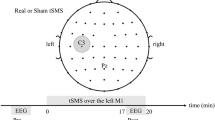Abstract
The effects of therapeutic SCS and transcranial electric stimulation on the functional activity of the brain in seven patients in the posttraumatic unconscious state were compared. The therapeutic transcranial stimulation was shown to exert a positive effect on the EEG and the characteristics of its spatial–temporal organization in most cases, which corresponds with positive shifts in the mental and motor sphere. The phasic character of changes in the bioelectric activity reflecting the sequence of involvement of the cerebral structures (primary activation of the deep frontal lobe divisions, activation of the subcortical-diencephalic structures, “activation” of the cortex) in the developing adaptive reactions, which helps understand their neurophysiological mechanisms, was described. It was established that the formation of the foci of persistent pathological activity with dominant characteristics in the brain is one of the possible complications of both SCS and transcranial electric stimulation. The mechanisms of their neurogenesis and the electrographic equivalents require further study. The data may serve as the basis for further clinical study of the influence of transcranial electric stimulation on the recovery of patients in postcomatose unconscious states.
Similar content being viewed by others
REFERENCES
Makarenko, A.N., Neurophysiological and Neurochemical Aspects of the Protective Influence of the Neocortex on Exposure to and Overdose of General Anesthetics, Doctoral (Med.) Dissertation, Moscow, 1993.
Tsubokawa, T., Deep Brain Stimulation Therapy for a Persistent Vegetative State, J. Neurotrauma, 1995, vol. 12, no. 3, p. 345.
Gimranov, R.F., Functional Reorganizations in the Visual Analyzer on Exposure to Rhythmic Photostimulation and a Pulsed Magnetic Field in Health and in Visual Afferentation Deficit, Cand. Sci. (Med.) Dissertation, Moscow, 1997.
Deliac, P.,Richer, E.,Berthomieu, J., et al., Electrophysiological Development under Thalamic Stimulation of Posttraumatic Persistent Vegetative State, Neurochirurgie, 1993, vol. 39, no. 5, p. 293.
Takizawa, T.,Satou, S.,Sanou, A., et al., High Cervical Medullary Electric Stimulation Therapy for Prolonged Disturbance of Consciousness after Diffuse Axonal Injury, Proc. 1st Annu. Meeting of the Soc. for Treatment of Coma, Kyoto, 1992, vol. 1, p. 107.
Matsui, T.,Asano, T.,Nakano, T., et al., Clinical Experience of Spinal Cord Stimulation in an Attempt of Treatment of Patients with Prolonged Coma, Proc. 1st Annu. Meeting of the Soc. for Treatment of Coma, Kyoto, 1992, vol. 1, p. 83.
Ohira, T., Effects of Spinal Cord Stimulation on the Vegetative State, Proc. 1st Annu. Meeting of the Soc. for Treatment of Coma, Kyoto, 1992, vol. 1, p. 101.
Funahashi, K.,Ogura, M.,Naka, D., et al., Spinal Cord Stimulation for Vegetative State-A Study of Optimal Stimulation Using EEG-Mapping, Proc. 2nd Annu. Meeting of the Soc. for Treatment of Coma, Kyoto, 1993, vol. 2, p. 51.
Korsakov, I.A. andMatveeva, L.V., The Influence of Visual Cortex Polarization on the Psychophysical Characteristics of Perception, in Psikhofizika sensornykh i sensomotornykh protsessov (Psychophysics of Sensory and Sensorimotor Processes), Moscow: Nauka, 1984, p. 193.
Bekhtereva, N.P., Zdorovyi i bol'noy mozg cheloveka (Human Brain in Health and Disease), Leningrad: Nauka, 1988.
Kositsyn, N.S. andSvinov, M.M., EEG Parameter of the Disturbance and Restoration of the Dendritic Structure of the Pleximorphic Layer of the Cerebral Cortex, Byull. Eksp. Biol. Med., 1991, no. 4, p. 346.
Artyukhina, N.I., Strukturno-funktsional'naya organizatsiya neironov i mezhneironal'nykh svyazei (Structural and Functional Organization of Neurons and Interneuronal Connections), Moscow: Nauka, 1979.
Skrebitskii, V.G. andVorob'ev, V.S., Brain Sections as the Adaptation Model under in vitro Conditions, in Adaptivnye funktsii golovnogo mozga (Adaptive Functions of the Brain), Baku, 1980, p. 172.
Eolchiyan, S.A.,Serova, N.K., andEliseeva, N.M., Damage to the Optic Nerve in the Craniocerebral Injury: The Effect of Percutaneous Electric Stimulation of the Optic Nerve, Tezisy I S”ezda neirokhirurgov RF (I Congr. of Neurosurgeons of the Russian Federation), Yekaterinburg, 1995, p. 48.
Zaitsev, O.S.,Dobrokhotova, T.A., andPotapov, A.A., Mental Recovery after Prolonged Posttraumatic Vegetative State, NTC of WFNS Meeting 95. Neurotrauma (Preventive Interactions Outcome), Greece, 1995, p. 59.
Grosswasser, Z. andSazbou, L., Outcome in 134 Patients with Prolonged Posttraumatic Unawareness: Part 2, J. Neurosurg., 1990, vol. 72, no. 1, p. 81.
Dobrokhotova, T.A.,Potapov, A.A.,Zaitsev, O.S., andLikhterman, L.B., Reversible Postcomatose Unconscious States, Sotsial. Klin. Psikhiatr., 1996, no. 2, p. 26.
Koptelov, Yu.M. andGnezditskii, V.V., Analysis of “Scalp Potential Fields” and Three-Dimensional Localization of the Sources of Epileptic Activity of the Human Brain, Zh. Nevropatol. Psikhiatr. im. S.S. Korsakova, 1989, vol. 89, no. 6, p. 11.
Gambarelli, Y.,Guerinel, G.,Cherrot, L., et al., Computerized Axial Tomography (An Anatomical Atlas of Serial Sections of the Human Body: Anatomy-Radiology-Scans), Berlin, 1977.
Pavlygina, R.A. andSokolov, S.S., The Role of the Dominant in Purpose-Oriented Animal Behavior, in Elektrofiziologicheskoe issledovanie statsionarnoi aktivnosti v golovnom mozge (Electrophysiological Study of Stationary Activity in the Brain), Moscow, 1983, p. 34.
Rusinova, E.V., The Effect of Stimulation of Dorsal Hippocampus Field CA3 on the Motor Polarization Dominant in Rabbits, Zh. Vyssh. Nervn. Deyatel., 1989, vol. 38, issue 3, p. 497.
Rusinov, V.S., Dominanta (elektrofiziologicheskoe issledovanie) (The Dominant (Electrophysiological Study), Moscow: Meditsina, 1969.
Podachin, V.P.,Musalov, G.G., andNezlina, N.I., Strukturno-funktsional'nye osnovy kompensatsii funktsii pri travme spinnogo mozga (Structural and Functional Basis of Compensation of Functions in a Spinal Cord Injury), Moscow: Nauka, 1983.
Sudakov, K.V., Obshchaya teoriya funktsional'nykh sistem (General Theory of Functional Systems), Moscow: Meditsina, 1984.
Beteleva, T.G. andFarber, D.A., Neurophysiological Analysis of Sensory Information Processing at the Involuntary Level, Tezisy dokl. XXX Vseross. soveshchaniya po problemam vysshei nervnoi deyatel'nosti (XXX All-Russia Meeting on the Problems of Higher Nervous Activity), St. Petersburg, 2000, p. 293.
Sharova, E.V.,Boldyreva, G.N.,Bragina, N.N., andKulikov, M.A., Adaptive-Compensatory Reorganizations of the Interhemispherical Interaction of Human Brain Electrical Processes in Stem Structure Lesions, Zh. Vyssh. Nervn. Deyatel., 1993, vol. 43, issue 6, p. 1089.
Sharova, E.V.,Manelis, N.G.,Kulikov, M.A., andBarkalaya, D.B., The Influence of Stem Structures on the Formation of the Functional State of the Cerebral Hemispheres, Zh. Vyssh. Nervn. Deyatel., 1995, vol. 45, issue 5, p. 876.
Author information
Authors and Affiliations
Rights and permissions
About this article
Cite this article
Sharova, E.V., Amcheslavskii, V.G., Potapov, A.A. et al. EEG Effects of Therapeutic Electric Stimulation of the Human Brain in the Posttraumatic Unconscious State. Human Physiology 27, 155–164 (2001). https://doi.org/10.1023/A:1011067014319
Issue Date:
DOI: https://doi.org/10.1023/A:1011067014319



